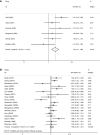Association Between NAT2 Polymorphism and Lung Cancer Risk: A Systematic Review and Meta-Analysis
- PMID: 33777732
- PMCID: PMC7991837
- DOI: 10.3389/fonc.2021.567762
Association Between NAT2 Polymorphism and Lung Cancer Risk: A Systematic Review and Meta-Analysis
Abstract
Lung cancer is the leading cause of cancer-related death worldwide and has a high incidence rate. N-Acetyltransferase 2 (NAT2) is a polymorphic xenobiotic enzyme, which can catalyze N-acetylation and O-acetylation of various carcinogens such as aromatic, heterocyclic amines and hydrazines. At present, many studies have explored the effects of NAT2 polymorphism on lung cancer, but we found inconsistent results. We researched 18 published studies, involving 4,016 patients and 5,469 controls, to more accurately assess the effects of NAT2 polymorphism on lung cancer risk and to investigate whether smoking is associated. We used STATA software to analyze the extracted data and used STATA for subgroup analysis, sensitivity analysis, and to perform publication bias tests. To determine the correlation, we used the crude odds ratio (ORs) with 95% confidence interval (CIs). Our study was prospectively registered in PROSPERO (CRD42020159737). The odds ratio was 1.53 (95% CI: 1.21-1.95, I² = 45.2%, P=0.104) for the NAT2 slow + intermediate phenotype versus rapid phenotype. The results suggested that people with NAT2 non-rapid (slow + intermediate) phenotype have a significantly increased risk of lung cancer. In addition, NAT2 rapid phenotype was significantly associated with reduced risk of lung cancer, compared with slow phenotype or intermediate phenotype (slow phenotype vs . rapid phenotype: OR: 1.61, 95% CI: 1.07-2.42, I²= 50%, P= 0.075; intermediate phenotype vs . rapid phenotype: OR: 1.47, 95% CI: 1.15-1.88, I²= 40.3%, P= 0.137).
Keywords: NAT2; genetic polymorphism; lung cancer; phenotype; systematic review.
Copyright © 2021 Zhu, Xu, Xia, Li, Zhang, Jiang, Zhou and Wang.
Conflict of interest statement
The authors declare that the research was conducted in the absence of any commercial or financial relationships that could be construed as a potential conflict of interest. The reviewer SF declared a shared affiliation, with no collaboration, with several of the authors, KZ, BZ, HJ, RW, to the handling editor at the time of review.
Figures





Similar articles
-
NAT2 polymorphisms combining with smoking associated with breast cancer susceptibility: a meta-analysis.Breast Cancer Res Treat. 2010 Oct;123(3):877-83. doi: 10.1007/s10549-010-0807-1. Epub 2010 Feb 24. Breast Cancer Res Treat. 2010. PMID: 20180012
-
Metabolic activation and deactivation of arylamine carcinogens by recombinant human NAT1 and polymorphic NAT2 acetyltransferases.Carcinogenesis. 1993 Aug;14(8):1633-8. doi: 10.1093/carcin/14.8.1633. Carcinogenesis. 1993. PMID: 8353847
-
Colorectal adenomatous and hyperplastic polyps: smoking and N-acetyltransferase 2 polymorphisms.Cancer Epidemiol Biomarkers Prev. 1999 Jan;8(1):69-75. Cancer Epidemiol Biomarkers Prev. 1999. PMID: 9950242
-
A meta-analysis of the association of N-acetyltransferase 2 gene (NAT2) variants with breast cancer.Am J Epidemiol. 2007 Aug 1;166(3):246-54. doi: 10.1093/aje/kwm066. Epub 2007 May 29. Am J Epidemiol. 2007. PMID: 17535831 Review.
-
Association Between N-acetyltransferase 2 Polymorphism and Bladder Cancer Risk: Results From Studies of the Past Decade and a Meta-Analysis.Clin Genitourin Cancer. 2016 Apr;14(2):122-9. doi: 10.1016/j.clgc.2015.10.007. Epub 2015 Oct 26. Clin Genitourin Cancer. 2016. PMID: 26585839 Review.
Cited by
-
High Expression of PSRC1 Predicts Poor Prognosis in Lung Adenocarcinoma.J Cancer. 2023 Oct 7;14(17):3321-3334. doi: 10.7150/jca.88635. eCollection 2023. J Cancer. 2023. PMID: 37928428 Free PMC article.
-
The impact of IDH and NAT2 gene polymorphisms in acute myeloid leukemia risk and overall survival in an Arab population: A case-control study.PLoS One. 2023 Jul 21;18(7):e0289014. doi: 10.1371/journal.pone.0289014. eCollection 2023. PLoS One. 2023. PMID: 37478088 Free PMC article.
-
High Expression of DEPDC1B Predicts Poor Prognosis in Lung Adenocarcinoma.J Inflamm Res. 2022 Jul 23;15:4171-4184. doi: 10.2147/JIR.S369219. eCollection 2022. J Inflamm Res. 2022. PMID: 35912402 Free PMC article.
-
Revealing the association between vitamin D metabolic pathway gene variants and lung cancer risk: a systematic review and meta-analysis.Front Genet. 2024 Feb 28;15:1302527. doi: 10.3389/fgene.2024.1302527. eCollection 2024. Front Genet. 2024. PMID: 38482381 Free PMC article.
-
Clinical Significance of NAT2 Genetic Variations in Type II Diabetes Mellitus and Lipid Regulation.Pharmgenomics Pers Med. 2023 Sep 13;16:847-857. doi: 10.2147/PGPM.S422495. eCollection 2023. Pharmgenomics Pers Med. 2023. PMID: 37724295 Free PMC article.
References
Publication types
LinkOut - more resources
Full Text Sources
Other Literature Sources

